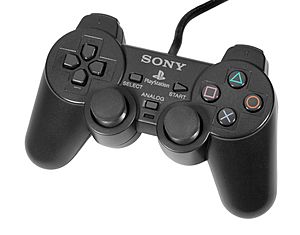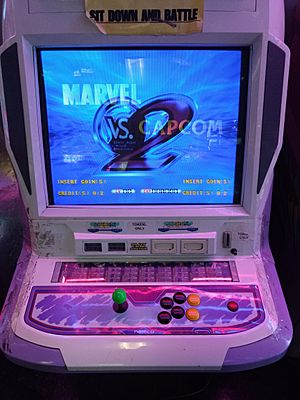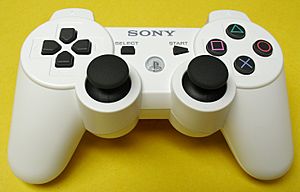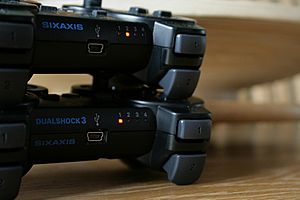DualShock facts for kids
The DualShock is a series of game controllers made by Sony Interactive Entertainment for their PlayStation consoles. These controllers are famous for their cool features like vibration feedback and analog sticks. First released in November 1997, the DualShock quickly became the main controller for the original PlayStation. It even replaced older controllers like the PlayStation controller and the Dual Analog Controller. The DualShock is the best-selling game controller ever, not counting those that came bundled with consoles.
Contents
DualShock
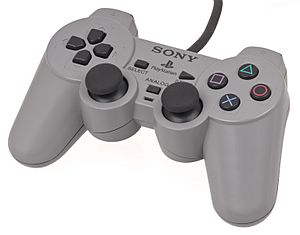
Original grey version of the DualShock controller
|
|
| Developer | Sony Interactive Entertainment |
|---|---|
| Manufacturer | Sony Corporation |
| Type | Gamepad |
| Generation | Fifth |
| Release date | November 20, 1997 |
| Input | Controller Port |
| Connectivity | PlayStation (2) controller port |
| Dimensions | Body
Cable
|
| Predecessor | Dual Analog |
| Successor | DualShock 2 |
The DualShock Analog Controller (model SCPH-1200) could make games feel more real by vibrating. For example, it might rumble when your character crashed or got hit. It also had two analog sticks, which let you move characters smoothly in any direction.
The name "DualShock" comes from its two (dual) vibration motors (shock). These motors are inside the controller's handles. The left motor is bigger and stronger than the right one. This allows the controller to create different levels of vibration. Unlike the Nintendo 64's Rumble Pak, which used only one motor and needed batteries, the DualShock got its power directly from the PlayStation console.
The DualShock improved on an earlier controller called the Dual Analog. The DualShock's analog sticks had textured rubber grips, which were better than the smooth plastic tips on the older controller. It also had longer handles and slightly bigger L2/R2 buttons.
The DualShock kept the classic PlayStation buttons. These included a direction pad, Start, Select, and the four famous shape buttons: a green triangle, a red circle, a blue cross, and a pink square. The designer, Teiyu Goto, meant for the circle to mean "yes" and the cross to mean "no," like in Japanese culture. The triangle was for a point of view, and the square was like a piece of paper for menus.
Many games quickly started using the DualShock's vibration and dual analog sticks. Popular games like Crash Bandicoot: Warped, Spyro the Dragon, and Tekken 3 supported its features. Some older games, like Porsche Challenge, also worked with the DualShock's vibration. Games like Gran Turismo even used both motors to create "stereo" vibration effects. In 1999, Ape Escape was the first game that absolutely needed a DualShock controller because its gameplay used both analog sticks.
In 2000, Sony released the PS one, a smaller version of the original PlayStation. It came with a slightly updated DualShock controller (SCPH-110(U)). This new controller had a "PSone" logo, purple-tinted buttons and sticks, and came in different colors.
The original DualShock controller works with the PlayStation 2 console. However, some PS2 games that used the DualShock 2's special analog buttons might not work perfectly with the older DualShock. But the DualShock is fully compatible when playing original PlayStation games on a PlayStation 2.
DualShock 2
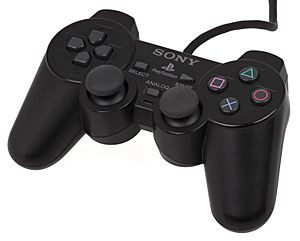
DualShock 2 controller
|
|
| Developer | Sony Interactive Entertainment |
|---|---|
| Manufacturer | Sony Corporation |
| Type | Gamepad |
| Generation | Sixth |
| Release date |
|
| Input | |
| Connectivity | PlayStation (2) controller port |
| Dimensions | Body
Cable
|
| Weight | 7.4 oz (0.21 kg) |
| Predecessor | DualShock |
| Successor | Sixaxis, DualShock 3 |
The DualShock 2 Analog Controller (SCPH-10010) came with the PlayStation 2. It looked almost the same as the first DualShock, but with a few small changes. It had a blue "DualShock 2" logo on top, and its cable and connector were black instead of grey. The standard controller was black, but many other colors came out later. The analog sticks on the DualShock 2 felt a bit stiffer than on the original.
Inside, the DualShock 2 was lighter. A big improvement was that almost all its buttons could sense how hard you pressed them. This is called "pressure-sensitive." The DualShock 2 could sense 256 different levels of pressure, which added more control to games.
The DualShock 2 was made in many colors, including black, silver, white, blue, green, and red. Some arcade games, like Tekken 5, even let players use DualShock or DualShock 2 controllers.
You can use a DualShock 2 with the original PlayStation. You can also use it with the PlayStation 3 by using special adapters. However, it won't work for games that need the motion-sensing features of the newer Sixaxis controller.
DualShock 3
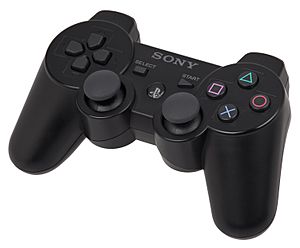
DualShock 3 controller
|
|
| Developer | Sony Interactive Entertainment |
|---|---|
| Manufacturer | Sony Corporation |
| Type | Gamepad |
| Generation | Seventh |
| Release date |
|
| Power | Lithium-ion battery (3.7 V 300 mA or 5.0 V 500 mA), USB host powered |
| Input |
|
| Connectivity | USB, Bluetooth (PS3 and PSP Go) |
| Dimensions | 160 mm × 97 mm × 55 mm (6.30 in × 3.82 in × 2.17 in) |
| Weight | 192 g (6.77 oz) |
| Predecessor | Sixaxis, DualShock 2 |
| Successor | DualShock 4 |
The DualShock 3 wireless controller (SCPH-98050/CECHZC2) was announced in 2007 for the PlayStation 3. It replaced the Sixaxis controller that came with earlier PS3 consoles. The DualShock 3 looked almost the same as the Sixaxis, but it added back the vibration feature that the Sixaxis didn't have. Sony had a legal issue that prevented the Sixaxis from having rumble, but they fixed it for the DualShock 3.
Both the vibration and the motion-sensing features of the DualShock 3 could work at the same time. Like the Sixaxis, it had a USB mini-B port for charging. You could also use it with a PSP Go via Bluetooth.
The DualShock 3 weighed about 192 grams, which was 40% heavier than the Sixaxis. It had a built-in battery that could last up to 30 hours on a full charge. You could also play while charging it using a USB cable.
Sony stopped making the Sixaxis controller after the DualShock 3 was released in 2008.
Variations
The DualShock 3 was made in many different colors, like black, silver, white, blue, red, pink, and even camouflage. Some special edition consoles also came with unique controller colors. For example, a baseball-themed controller was released with the game MLB 11: The Show.
DualShock 4

DualShock 4 controller
|
|
| Developer | Sony Interactive Entertainment |
|---|---|
| Manufacturer | Sony Corporation |
| Type | Gamepad |
| Generation | Eighth |
| Release date | |
| Power | 3.7 V 1000 mAh Li-ion battery, USB 3.0 host powered |
| Input |
|
| Connectivity | microUSB (Micro-B) 2.0, Bluetooth v2.1+EDR, 3.5 mm TRRS (CTIA) stereo headset jack, extension port |
| Dimensions | 162 mm × 52 mm × 98 mm (6.4 in × 2.0 in × 3.9 in) |
| Weight | 210 g (7.4 oz) |
| Predecessor | DualShock 3 |
| Successor | DualSense |
The DualShock 4 (CUH-ZCT1 or CUH-ZCT2) is the controller for the PlayStation 4. It added several new features compared to the DualShock 3. One new feature is a built-in touch pad on the front, which you can also click like a button. This touch pad can be used for different actions in games. The controller also has motion sensing and vibration. It has a rechargeable battery that can be charged even when the PS4 is in rest mode.
On the front of the controller, there's a light bar with three LEDs. This light bar can glow in different colors. It helps the PlayStation Camera know where players are and how they're moving. It can also change colors to give you feedback in games. For example, in Grand Theft Auto V, the light bar flashes red and blue when the police are chasing you.
The controller has a headphone jack, a micro-USB port for charging, and a small speaker. The speaker is a cool feature that lets sounds come directly from the controller.
The DualShock 4 has new buttons too. The old START and SELECT buttons were combined into one "OPTIONS" button. There's also a new "SHARE" button that lets players easily upload screenshots and videos of their gameplay. The analog sticks and triggers were also redesigned to feel better.
Unlike the DualShock 2 and 3, only the L2 and R2 triggers on the DualShock 4 are pressure-sensitive. This change was made because most games didn't use the pressure-sensing feature on other buttons.
You can use a DualShock 4 with a PlayStation 3, but some features like motion and vibration won't work. The OPTIONS and SHARE buttons replace the old START and SELECT buttons. The DualShock 4 also works with PS4 games on the PlayStation 5.
Version issues and modifications
Some early DualShock 4 controllers (CUH-ZCT1) had issues where the rubber on the analog sticks would wear out quickly. Sony acknowledged this problem in 2014.
In 2016, Sony released a second version of the DualShock 4, called the DualShock Version 2 (CUH-ZCT2). This version had small improvements, like better triggers and joysticks, longer battery life, and a way to see the light bar from the top of the touch pad.
The light bar on the first version of the controller was always bright. Players wanted to dim it to save battery. Sony later released an update that allowed users to dim the light bar.
Variations
The DualShock 4 came in many colors, including black, white, blue, red, gold, and silver. The newer DualShock 4 (Version 2) added even more colors, like rose gold, electric purple, and different camouflage patterns.
Sony also released special edition DualShock 4 controllers with console bundles. These included designs for games like Batman: Arkham Knight, Metal Gear Solid V: The Phantom Pain, and God of War.
DualSense

DualSense controller
|
|
| Developer | Sony Interactive Entertainment |
|---|---|
| Manufacturer | Sony Corporation |
| Type | Gamepad |
| Generation | Ninth |
| Release date |
|
| Power | 3.65 V 1560 mAh Li-ion battery (non-removable) |
| Input |
|
| Connectivity | USB-C, Bluetooth 5.1, 3.5 mm TRRS (OMTP) stereo headset jack |
| Dimensions | 160 mm × 66 mm × 106 mm (6.3 in × 2.6 in × 4.2 in) |
| Weight | 280 g (9.88 oz) |
| Predecessor | DualShock 4 |
The DualSense (CFI-ZCT1W) is the controller for the PlayStation 5. It was revealed in April 2020. It builds on the DualShock 4 but has a new design and improved features based on feedback from game designers and players.
Here are some key differences of the DualSense:
- Advanced Vibration: The DualSense has special motors that create very detailed vibrations. For example, you might feel the difference between walking on sand or mud in a game.
- Adaptive Triggers: The L2 and R2 buttons (triggers) can change how much resistance they have. This means you can feel the tension of a bowstring as you pull it in a game, or the kick of a gun.
- New Look: The DualSense has a two-tone color scheme, usually white with black. For the first time, the main action buttons (triangle, circle, cross, square) are not colored. It's also a bit bigger and rounder than the DualShock 4.
- Light Bar and Player Indicator: The light bar moved from the top to the edges of the touch pad. Now, a row of 5 small lights below the touch pad shows which player you are.
- Improved Sound and Microphones: The controller's speaker is better, and it now has two built-in microphones. This lets players talk to each other without needing a separate headset. You can even use voice typing on the PS5!
- USB-C: It uses a newer USB-C port for charging, which is more common now.
- Bigger Battery: The battery inside is more powerful, so it can last longer.
Some players have reported an issue where the analog sticks on the DualSense can sometimes move on their own, even when not being touched. This is called "drift."
Microtexture
The DualSense has a special microtexture on its lower shell. This texture is made of 40,000 tiny PlayStation symbols (squares, triangles, circles, crosses) stacked on top of each other. These tiny symbols make the controller easier to grip and more comfortable to hold for a long time. Designers tried many different patterns before choosing this one. One small downside is that this texture can sometimes pick up dirt easily.
|
See also
 In Spanish: DualShock para niños
In Spanish: DualShock para niños



